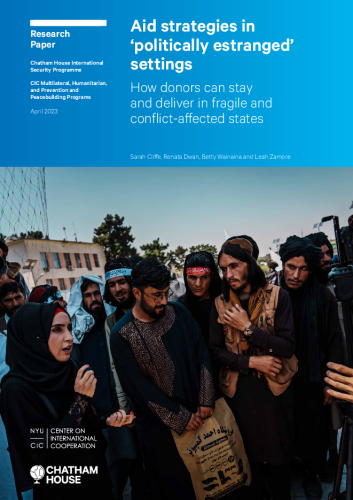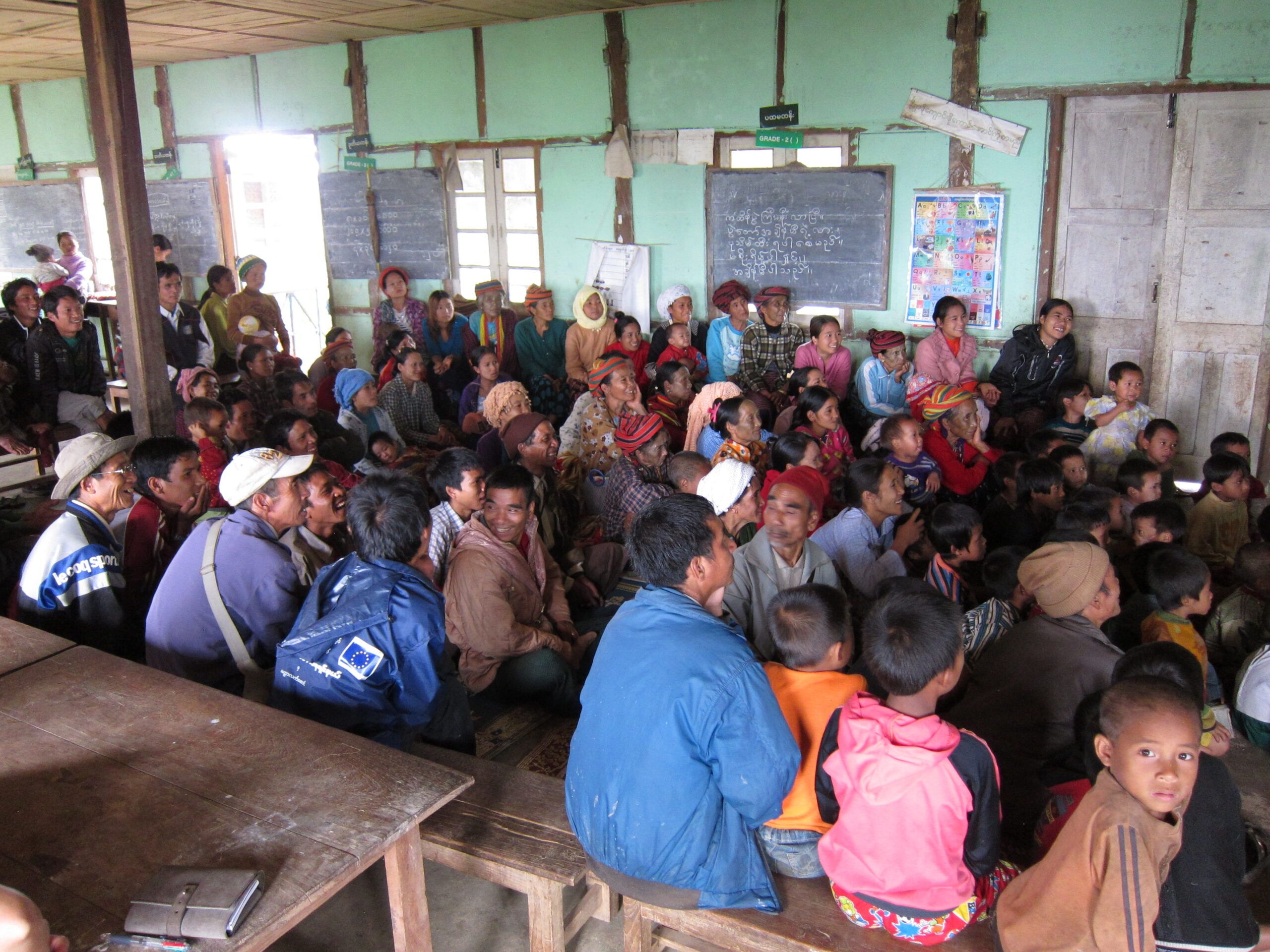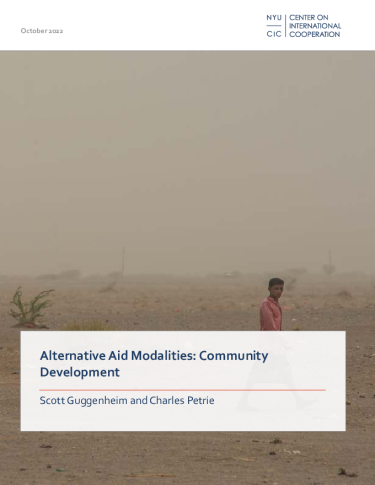Markus Kostner is a Senior Fellow at New York University’s Center on International Cooperation (CIC). At an event hosted by the World Bank to commemorate the 75th anniversary of the Universal Declaration of Human Rights (UDHR), a panel of experts discussed how the Bank and the international community at large can reach and empower people in conflict situations, I reflect on the deliberations.
—
There is nothing that suggests that local empowerment cannot be a central element of humanitarian aid.[1] However, it requires a different vision of the “how” and the “what” of aid. In other words, it requires a different mental model with a much-reduced role for well-intentioned but costly and often less effective international intermediaries.
Considering its long-standing experience with local empowerment and more nascent cooperation with humanitarian actors, the Bank can and should use its convening power to advance alternative aid delivery and oversight models in situations where human rights are under duress. In so doing, it can enhance humanitarian aid’s adequacy and effectiveness while advancing dignity, fairness, and agency—core tenets of the UDHR.
Traditional humanitarian aid models are increasingly overstretched…
Article 1 of the UDHR states, “All human beings are born free and equal in dignity and rights.” There is no more concise summary of the principle that underpins inclusive development, the Bank’s core mandate. And no population groups are further away from this ideal than those in conflict-affected and fragile states.
Today, more than 50 percent of the population of fragile states lives in situations where relations between ruling authorities and major development donors are estranged. Many of these countries are “forgotten crises,” like Sudan, where more than 7.2 million were displaced in 2023. They attract far less aid than needed, and what is received commonly bypasses established institutional channels. The traditional development model thus does not reach a significant proportion of the world’s poor. Such indifference runs the risk of exacerbating global perceptions of double standards.
The traditional humanitarian model, a decades-old tried-and-tested emergency aid system, has saved countless lives. Though not designed for this purpose, its principles of humanity, neutrality, impartiality, and operational independence have made it a sought-after delivery modality for “politically estranged” situations as well.
Given the scale and duration of the world’s crises, however, the system has become increasingly overstretched and underfunded. Witness the plight of the Rohingya refugees in Bangladesh who, in 2023, saw their monthly World Food Programme (WFP) food voucher value drop from USD 12 (when 40 percent of children under five were already chronically malnourished) to USD 8.
Moreover, all too often, the shift towards humanitarian aid has been accompanied by donor disengagement from development, which has had unintentional consequences. Notably, without continued development engagement, the collapse of the local institutions that are key to delivering both development and human rights and preventing a brain drain due to lost livelihoods becomes almost inevitable, making any post-conflict recovery ever more daunting and costlier.
There are clear reasons for donors to stay engaged during situations of conflict and estrangement. These include national and geopolitical interests as well as collective security and ethical reasons to meet urgent needs, prevent further social and economic disruption and spillovers, and support a transition to normal relations where possible—without ignoring the sources of estrangement. The Bank’s policy on Development Cooperation and Fragility, Conflict, and Violence (FCV) puts it succinctly: “to protect human capital, institutions, and development gains,” purposes fully compatible with the UDHR. This reasoning pertains as much to the “how” of aid as to the “what.”
…while alternative models are readily available
There is increasing appreciation that there are non-traditional modalities to engage that reflect the greater risks to development effectiveness posed by a regime’s abrogation of human rights. Among these are local institutions— local organizations, community groups, local governance structures—that are often protectors against further loss of development gains and abuse of human rights.
There are plenty of reasons why and evidence that local institutions are effective in aid delivery and oversight. They are nimble and can adjust swiftly to emerging challenges. They can access communities beyond humanitarian agencies’ reach and have an intimate understanding of their needs. They are noticeably more cost-effective than traditional humanitarian aid providers. They empower communities to be the drivers of the aid they receive. In pre-coup Myanmar, for example, villages with strong participatory local governance structures responded better to the COVID-19 pandemic than other villages. Local institutions are also first responders in a world increasingly beset by natural disasters in the context of a changing climate.
Furthermore, strengthening local institutions is a “no regret” investment, important regardless of the direction and speed of a political or peace process. Many will be there in the long run and will be the nascent institutions upon which we can build future recovery and development. Conversely, when local institutions fail, the space they leave behind can be filled by more criminal, predatory, or abusive networks, including transnational crime and extremist groups.
Nevertheless, there is a general reluctance among donors to channel financial aid to local institutions even when a regime lacks legitimacy. Fiduciary and governance risks have been a common concern, and the complexity of working with a greater number of smaller actors in a complex political environment is another. In the long run, institutional fortitude to stay the course and engage local institutions has been rare. All too often, donors have opted to use traditional humanitarian delivery models instead.
Enter resilience
Humanitarian aid and sustainability may seem like a contradiction in terms. Since the early 2000s, donors and humanitarian agencies have applied a “humanitarian plus” approach to emergency situations to close the gap in development assistance. While effective within its remit, this approach risks being self-perpetuating. On the one hand, there are the well-known risks of dependency when people are passive recipients of aid, as has so often been the case. On the other hand, no local economy can function even at an elementary level without critical prerequisites such as utilities and a financial system, essentials not commonly featured in humanitarian aid. Recognizing these limitations, support for payment systems has been central in donor debates on humanitarian aid priorities in Afghanistan.
A resilience perspective can improve the prospect of aid sustainability. It calls for humanitarian aid beyond sustaining lives and essential services and livelihood activities and emphasizes building human capital and supporting the local economy. Aid also needs to invest in the capacity of people, communities, and local institutions and provide the means to withstand shocks on their own and manage their own affairs. In short, resilience requires aid that aims to help people not just to survive but to empower them to thrive. A focus on resilience thus calls for a longer-term vision, which is a natural engagement area for the Bank.
The Bank can help adapt the traditional humanitarian model…
In implementing its FCV policy, the Bank is moving in the right direction. While circumscribed by a provision in its Articles of Agreement that “[t]he Bank and its officers shall not interfere in the political affairs of any member” and the requirement that “[o]nly economic considerations shall be relevant to their decisions,” the Bank has intensified its cooperation with humanitarian actors in “politically estranged” situations. Let us look at two recent examples of how the Bank can add a development perspective to what is, in essence, humanitarian aid.
Building on its long-standing national community-driven development (empowerment) projects in Afghanistan and Myanmar, the Bank has added a resilience lens to new projects after the unconstitutional changes in government. International organizations implement them.
- The Afghanistan Community Resilience and Livelihoods Project uses still functioning community development councils set up under the earlier National Solidarity Project. The project mobilizes communities for implementation and oversight and thus gives people a degree of agency and (re-)builds local capacity.
- By contrast, the Myanmar Community Support Project, implemented in a context of active conflict, follows traditional humanitarian modalities and uses direct execution and non-governmental organizations as intermediaries. At the same time, it includes a participatory third-party monitoring mechanism for community oversight that sheds light on how communities perceive the effectiveness of the aid, information that, in turn, is fed back into implementation.
Projects like these do not yet unlock the full potential of local institutions, but they are useful experiences that can be built on.
… such that it reflects human rights principles
Many human rights principles are central to local empowerment. Empowerment done right brings people together in a peaceful environment to discuss matters of common concern. It allows them to determine their needs and provides them the means to address them. It gives space to women, the poor, the marginalized, and ethnic and other minorities. It invites people to elect community members to represent them in collective decision-making. It makes information about project funds transparent. And it allows people to seek accountability, raise grievances, and resolve them.
Processes and procedures have been tried and tested, and evidence of their effectiveness exists—it is time to finally act accordingly. Local empowerment not only brings economic and social benefits, but it also has an intrinsic value: it fosters people’s self-worth and thus, a belief that they themselves can contribute to a brighter future. Imbuing humanitarian aid with such principles is nowhere more important than when people are denied their human rights.
[1] By “local empowerment” I mean the empowerment of people, communities and local institutions.



